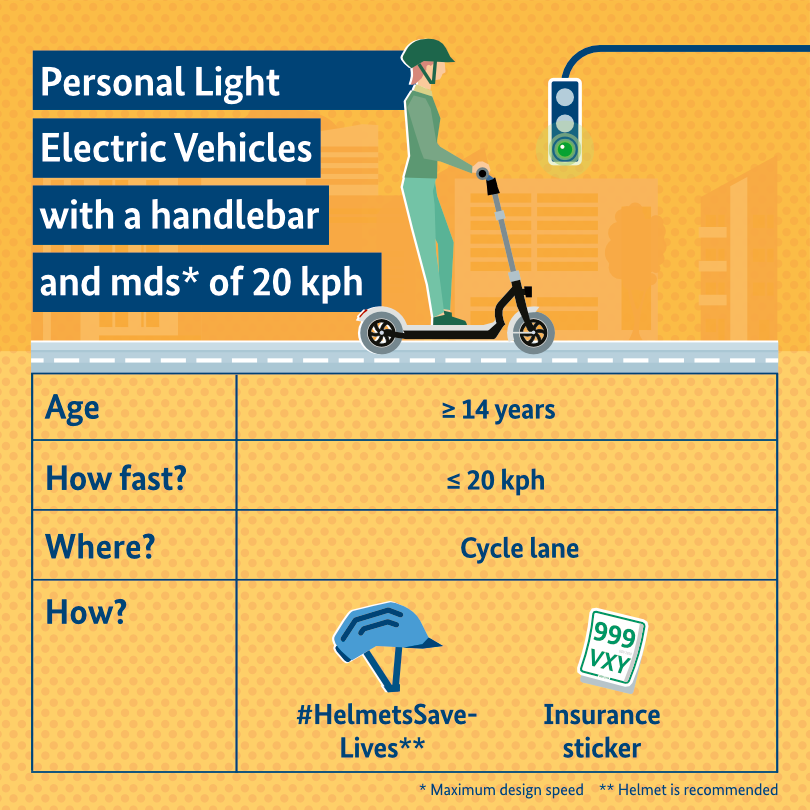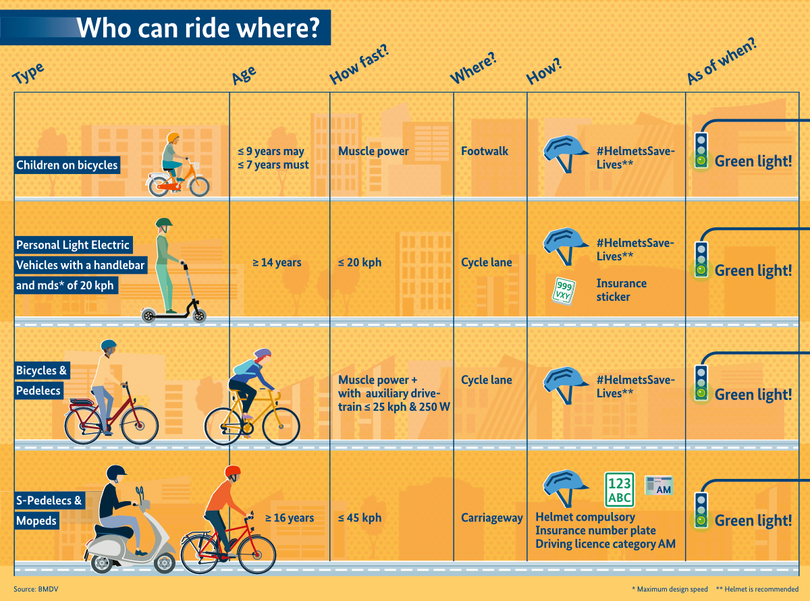
Source: BMDV
When we talk about micro mobility, we are referring to smaller vehicles with electric drivetrains, such as electric scooters and Segways. They are referred to by the term “Personal Light Electric Vehicles”.
These vehicles are battery-driven and thus emit zero emissions. A special feature of many of these vehicles is that they are very small and lightweight, thus allowing for a foldable and portable design. This enables the users to take the vehicles on public transport, which is why they have a special added value with regard to linking different means of transport and to covering short distances in particular (so-called “last mile mobility”).
With the entry into force of the Personal Light Electric Vehicles Regulations on 15 June 2019, the foundations have been laid to allow the use of Personal Light Electric Vehicles with a handlebar or a stanchion on public roads.
In addition, a list of the general type approvals issued for Personal Light Electric Vehicles has been published on the Federal Motor Transport Authority’s (KBA) website which can be found here (in German only):
Link to the Federal Motor Transport Authority (KBA) - list of the general type approvals.
We thereby want to allow for new forms of modern, environmentally-friendly and clean mobility in our cities, while at the same time ensuring safety on our roads.
Below, you can find the most important questions and answers concerning Personal Light Electric Vehicles.
Where am I allowed to use Personal Light Electric Vehicles?
As a general rule, Personal Light Electric Vehicles must be operated on traffic spaces for cyclists where such spaces are available. If there is a physically separated cycle track, an advisory cycle lane or a cycle lane, Personal Light Electric Vehicles must use it. This applies regardless of whether the use of the cycle track or lane is mandatory for cyclists or not. The rules of the road that apply to Personal Light Electric Vehicles thus differ here from those applying to bicycles. If there are no physically separated cycle tracks or cycle lanes, Personal Light Electric Vehicles can be used on the carriageway and, outside built-up areas, also on the hard shoulder.
Can Personal Light Electric Vehicles be used on the sidewalk when the motor has been switched off?
No. Even if the motor has been switched off, Personal Light Electric Vehicles may only be operated on the designated traffic spaces. It is not possible to change the category of a vehicle in operation, for example by switching off the motor.
Do I need a driving license?
No. There is no driving license obligation or obligation to carry a test certificate for motor-assisted bicycles.
What is the minimum age?
Personal Light Electric Vehicles can be used from the age of 14 years and above.
Do I have to insure my Personal Light Electric Vehicle?
Yes. Personal Light Electric Vehicles are motor vehicles and thus have to be insured. Due to their small size and special design features, a small insurance sticker has been introduced for these vehicles.
Am I allowed to operate a Personal Light Electric Vehicle under the influence of alcohol?
The blood alcohol limit of 0.05 % laid down in Section 24a of the German Road Traffic Act also applies to Personal Light Electric Vehicles. However, even with a blood alcohol concentration (BAC) of 0.03 % or more, you are liable to prosecution if you are no longer able to drive safely while under the influence of alcohol. For under 21-year-olds and novice drivers in the probationary period, the zero alcohol limit applies here, too. The relevant penalty and fine regulations governing the operation of motor vehicles in road traffic apply here. For example, a BAC of 0.05 % may result in a fine of € 500 and a driving ban for 1 month. In addition, 2 penalty points will be recorded in the Register of Driver Fitness.
What else is prohibited?
Among other things, it is forbidden to ride with another person or objects on the footboard, to use footways and pedestrian zones, to be towed by another vehicle, and to obstruct or endanger other road users. In addition, the general road traffic law provisions apply, in particular the requirement of constant care and mutual respect.
Can Personal Light Electric Vehicles be carried on public transport?
The Federal Ministry for Digital and Transport supports the carriage of Personal Light Electric Vehicles on public transport, however it cannot oblige transport operators to allow for it.
In general, the rules on the carriage of objects on local public transport apply. Details can be found in Section 11 of the Regulations on the General Conditions of Carriage for Tram and Trolleybus Services and Regular Motor Vehicle Services and, where applicable, the special conditions of carriage of the respective transport operator. Rules on carriage by railway undertakings might also be found in the special conditions of carriage of the transport operator concerned. The carriage of Personal Light Electric Vehicles must not jeopardize safe and orderly operations or inconvenience other passengers.
Are other road users safe?
The Personal Light Electric Vehicles Regulations strike a good balance between introducing new forms of mobility on the one hand and ensuring road safety on the other hand. This applies to all road users. In addition, the implementation of the Personal Light Electric Vehicles Regulations was being scientifically monitored and evaluated by the Bundesanstalt für Straßenwesen (Federal Highway Research Institute).
Why do we need national regulations on Personal Light Electric Vehicles?
At European level, the Type Approval Regulation (EU) No 168/2013 for two- or three-wheel vehicles and quadricycles entered into force in January 2016. Self-balancing vehicles and vehicles without a seat are explicitly excluded from the scope of application of this regulation.
Until the Personal Light Electric Vehicles Regulations came into force on 15 June 2019, only specific self-balancing mobility aids – e.g. so-called “Segways” – could be used in public road traffic in Germany in accordance with the Mobility Aid Regulations. Therefore, the Ministry has developed the Personal Light Electric Vehicles Regulations to enable the use of Personal Light Electric Vehicles with handlebars or stanchions to participate in public road traffic, regardless of their type.
What are the key elements of the regulations?
Personal Light Electric Vehicles with the following features are allowed to use public roads:
- handlebars or stanchions,
- maximum design speed between 6 kph and 20 kph,
- power limitation to 500 W (1,400 W for self-balancing vehicles),
- minimum road safety standards (e.g. regarding braking and lighting systems, dynamics of vehicle movements and electrical safety),
- the vehicle must have been issued with a general type approval or individual type approval and bear a valid insurance sticker.

Source: BMDV
What is the difference between Personal Light Electric Vehicles, Pedelecs and S-Pedelecs?
Pedelecs are vehicles with an electric auxiliary drivetrain whose supporting function decreases progressively with increasing speed. This means that as soon as a speed of 25 kph has been reached or the rider has stopped pedalling, the auxiliary drivetrain automatically stops. Thus, the distinguishing feature of a Pedelec is that the electric motor supplements the rider’s muscle power and only has a supportive function. With regard to the rules of the road applying to them, these vehicles have the same status as bicycles.
So-called S-Pedelecs are vehicles with an electric auxiliary drivetrain that can reach a speed of up to 45 kph, when muscle and motor power are combined, and are therefore classified as mopeds. Their riders are obliged to wear a helmet, to have their vehicle insured, to hold an appropriate driving license and to use the carriageway.
In this respect, Personal Light Electric Vehicles are a new vehicle category, because they are only powered by their electric motor.

Source: BMDV
What about Personal Light Electric Vehicles that can drive faster than 20 kph?
Currently, the approval of such vehicles for use on public roads is not planned.
What rules apply to Personal Light Electric Vehicles in other EU countries?
Since there is no uniform European framework, the requirements to be met by Personal Light Electric Vehicles vary between the Member States of the European Union (EU). Some EU Member States have not regulated or have even completely ruled out the use of Personal Light Electric Vehicles on public roads. However, most EU Member States do have corresponding regulations. Most of them provide for a speed limit of 20 to 25 kph for Personal Light Electric Vehicles. There are also different approaches regarding permissible traffic spaces.
What rules apply to already approved Personal Light Electric Vehicles (e.g. Segways)?
The Mobility Aid Regulations have been replaced by the Personal Light Electric Vehicles Regulations. However, the approvals issued under the former regulations remain valid. Since the Personal Light Electric Vehicles Regulations came into force, the rules included in them also apply to vehicles already approved.
Can vehicles which were already offered for sale before the entry into force of the Personal Light Electric Vehicles Regulations but do not comply with the requirements set out in the Personal Light Electric Vehicles Regulations be retrofitted?
Yes.
With the entry into force of the Regulations, manufacturers can apply for a general type approval from the Kraftfahrt-Bundesamt (Federal Motor Transport Authority) for vehicles that meet the requirements of the Personal Light Electric Vehicles Regulations.
Vehicles already on the market that do not comply with the Regulations can be retrofitted by the manufacturer so that they meet the requirements set out in the new Regulations.
Owners of vehicles that comply with the Regulations but are not provided with a subsequent general type approval by the manufacturer can operate them on public roads with an individual type approval if they meet the relevant technical requirements.